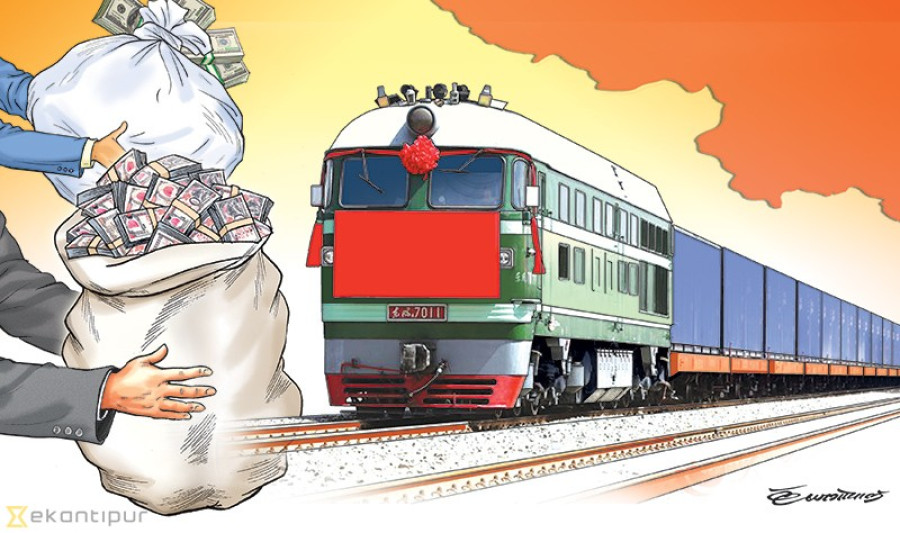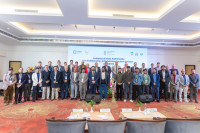National
China pledges Rs 2 billion in grant for railways, but where will it go?
The Chinese grant could either go towards funding a detailed project report for the cross-border Kerung-Kathmandu railway, or towards a feasibility study for two domestic lines.
Anil Giri
The Chinese government will be providing Nepal with a Rs 2 billion grant to go either towards pursuing the cross-border railway or two internal railway links, according to the governmental red book released on Tuesday.
Though no formal agreement with China on a grant has been reached, the fourth meeting of the Nepal-China railway talks, to be held in China within this month, will ascertain where exactly the money will go.
Balaram Mishra, director-general of the Department of Railways, said that it was uncertain whether the money will be spent towards preparing a detailed project report for the cross-border Kerung-Kathmandu railway or towards conducting two feasibility studies for the Kathmandu-Pokhara and Pokhara-Lumbini railways.
“I too learned from the red book that Rs 2 billion as a grant from China was allocated to our department,” Mishra told the Post. “But it is not certain where the grant will go. We are holding a meeting with the Chinese side within this month, after which we will be in a position to say something.”
A detailed project report—also confusingly called a feasibility study by the Chinese—for the Kerung-Kathmandu railway and feasibility studies of both the Kathmandu-Pokhara and Pokhara-Lumbini railways will now be carried out with the Chinese grant. Preparing a detailed project report for the Kerung-Kathmandu railway itself is a multi-billion-rupee project that is expected to be completed within two years.
China conducted a feasibility study for the Kerung-Kathmandu-Pokhara-Lumbini rail project at its own cost. In December last year, the National Railway Authority of China handed over the feasibility study report of the Kathmandu-Kerung railway to Nepali officials and had agreed to prepare a detailed project report of the cross-border railway.
Earlier, the Ministry of Finance had officially requested the Chinese government to provide a grant to conduct the feasibility study and survey for the railway lines, which have captured the Nepali imagination ever since KP Sharma Oli became prime minister last year and Beijing included the projects in its Belt and Road Initiative.
The cross-border railway project, which is an important component of the Trans-Himalayan Multi-dimensional Connectivity Network between Nepal and China, was recently incorporated into the Belt and Road Initiative at the Second Belt and Road Forum for International Cooperation. The Initiative has been touted by China as an ambitious plan to link the region infrastructurally, but some in Nepal and the West have cautioned about a possible debt trap.
Earlier, at a press conference in late May, Chinese Ambassador to Nepal Hou Yanqi had told the media that the cross-border railway is a complex project that will take time to construct.
“The transborder railway is very important for both the countries, but owing to the difficult geography, construction is not an easy job,” said Hou. “It is not going to be ready overnight.”
However, the scheduled fourth meeting of railway officials had been deferred for months after a vacancy at the China national railway administration leadership.
“We are in touch with the Chinese side and the fourth meeting is scheduled to take place soon. As the Finance Ministry has allocated the budget to be funded by China, this means we are getting a grant, but we are not sure where the Chinese side wants to put its money,” said Mishra.
Two senior officials at the ministry told the Post that while negotiations with China are ongoing, it was Nepal’s position to provide a grant to conduct all surveys, including preparing a detailed project report of the Kerung-Kathmandu and Kathmandu-Pokhara and Pokhara-Lumbini railways. But since it is Chinese money, it is up to them whether they will prepare a detailed project for Kerung-Kathmandu or a feasibility study of Kathmandu-Pokhara and Pokhara-Lumbini railways, said one Finance Ministry official on condition of anonymity because he was not allowed to speak to the media.
After completing the detailed project report, the next step will be to decide the investment modality of the $2.75 billion Nepal-China railway, which would stretch 72.25 km from the Chinese border down to Kathmandu. As per the report, around 98.5 percent of the railway would either be bridges or tunnels, and the per kilometre construction cost would be Rs 3.55 billion.
The pre-feasibility report had stated that engineering crew would build ramps along the northern and southern slopes leading to Lake Paiku, near Kerung, to connect tracks to the Kathmandu section. The ramps would overcome great differences in elevation between the southern and northern toes of the mountains, it said.
The preliminary findings suggest that the Kathmandu section is in the “collision and splicing zone” along the Eurasian Plate, presenting six major geological problems. The feasibility study described the cross-border railway as “complicated and arduous”.
Initially, Nepal had insisted that China fund the detailed project report fully, but Beijing had been asking for a 50 percent contribution from Nepal.




 15.12°C Kathmandu
15.12°C Kathmandu















